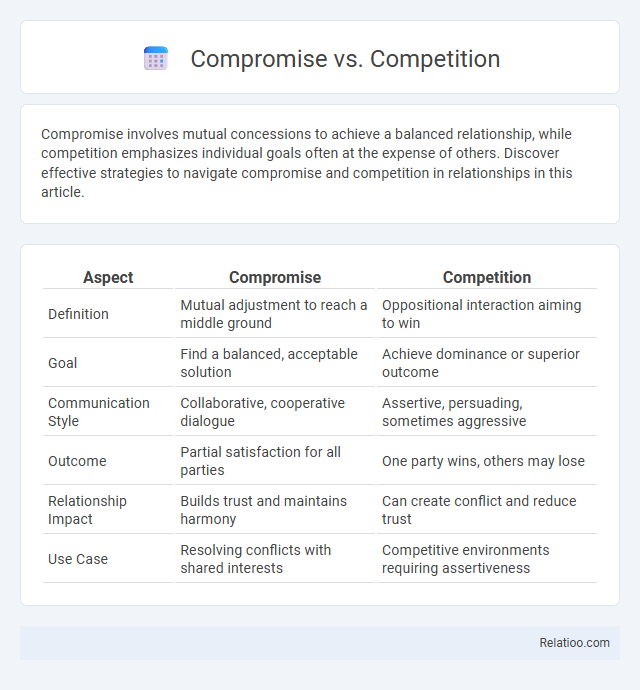Compromise involves mutual concessions to achieve a balanced relationship, while competition emphasizes individual goals often at the expense of others. Discover effective strategies to navigate compromise and competition in relationships in this article.
Table of Comparison
| Aspect | Compromise | Competition |
|---|---|---|
| Definition | Mutual adjustment to reach a middle ground | Oppositional interaction aiming to win |
| Goal | Find a balanced, acceptable solution | Achieve dominance or superior outcome |
| Communication Style | Collaborative, cooperative dialogue | Assertive, persuading, sometimes aggressive |
| Outcome | Partial satisfaction for all parties | One party wins, others may lose |
| Relationship Impact | Builds trust and maintains harmony | Can create conflict and reduce trust |
| Use Case | Resolving conflicts with shared interests | Competitive environments requiring assertiveness |
Understanding Compromise and Competition
Compromise involves each party making concessions to reach a mutually acceptable solution, fostering collaboration and maintaining relationships. Competition, on the other hand, centers on one party winning at the expense of another, often escalating conflict but driving innovation and decisive outcomes. Understanding the dynamics between compromise and competition is essential for effective conflict resolution and strategic decision-making in both personal and professional contexts.
Key Differences Between Compromise and Competition
Compromise involves mutual concession where parties collaborate to reach a solution beneficial to all, prioritizing relationship preservation and shared goals. Competition centers on winning or outperforming others, often leading to a zero-sum outcome where one party's gain is another's loss. Key differences highlight compromise's emphasis on cooperation and balance, while competition prioritizes individual success and rivalry.
The Psychology Behind Compromise
The psychology behind compromise reveals a deep-rooted human desire for cooperation and social harmony, balancing individual needs with group dynamics. Compromise often activates areas in the brain associated with empathy and reward, encouraging mutual understanding and long-term relationship building. Your ability to effectively negotiate compromise can reduce conflict intensity and foster emotional resilience in both personal and professional interactions.
The Benefits and Drawbacks of Competition
Competition drives innovation and motivates individuals or companies to improve performance, often leading to higher quality products and services. It can foster efficiency and quick decision-making but may also cause stress, reduce collaboration, and create a winner-takes-all environment that overlooks collective benefits. Excessive competition risks damaging relationships and long-term sustainability by fostering a zero-sum mindset where one party's gain is perceived as another's loss.
When to Choose Compromise Over Competition
Choosing compromise over competition is ideal when maintaining relationships and achieving mutual benefits are more important than winning outright. In situations where collaboration fosters long-term success and ensures everyone's interests are acknowledged, compromise prevents conflicts from escalating. Your ability to prioritize shared goals over individual victories is crucial for sustainable teamwork and conflict resolution.
Impact on Relationships and Team Dynamics
Compromise fosters collaboration by encouraging mutual concessions, which strengthens trust and promotes harmony within teams. Competition can drive innovation and performance but may increase tension and reduce cooperation if not managed carefully. Avoiding compromise often leads to conflict escalation, damaging relationships and hindering effective team dynamics.
Conflict Resolution: Compromise vs. Competition
Conflict resolution strategies often involve compromise and competition, which serve different purposes in managing disputes. Compromise seeks a middle ground where both parties make concessions to reach a mutually acceptable solution, promoting collaboration and long-term relationships. Competition emphasizes winning by asserting one's position, often leading to quick decisions but potentially damaging relationships and creating resentment.
Balancing Compromise and Competition in the Workplace
Balancing compromise and competition in the workplace fosters a collaborative yet dynamic environment where team members respect diverse perspectives while striving for excellence. You can enhance productivity by encouraging healthy competition that drives innovation alongside compromise that nurtures mutual understanding and conflict resolution. Effective leadership involves recognizing when to prioritize compromise to maintain harmony and when to harness competition to motivate and achieve organizational goals.
Real-Life Examples of Compromise and Competition
Compromise in real life often occurs when two colleagues negotiate project deadlines, each adjusting their expectations to meet midway and ensure team success. Competition is evident in sports, like the Olympics, where athletes strive to outperform rivals and win medals, pushing personal limits. Your ability to balance compromise and competition can improve collaborative outcomes and drive personal achievement in everyday challenges.
Striking the Right Balance for Sustainable Success
Striking the right balance between compromise and competition fosters sustainable success by leveraging the strengths of both cooperation and healthy rivalry. Compromise ensures mutual respect and collaboration, while competition drives innovation and performance improvements. Organizations that integrate these dynamics strategically create resilient cultures capable of adapting and thriving in complex environments.

Infographic: Compromise vs Competition
 relatioo.com
relatioo.com